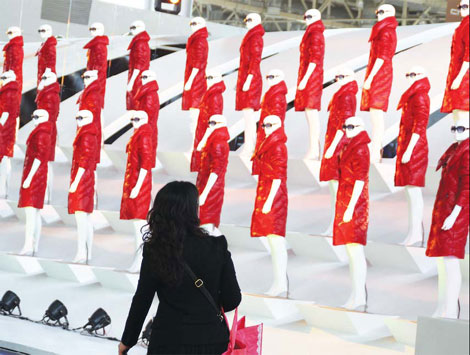Economy
Overseas trademarks a hot item
Updated: 2011-04-22 14:20
By Lin Jing (China Daily European Weekly)
More and more Chinese apparel enterprises are looking to register their trademarks overseas to boost their image and sales at home, according to trademark agencies in China, but as the trend picks up steam, shoppers are growing more concerned that they are being misled by the clothing companies.
|
 Chinese apparel makers are keen to acquire foreign brands to polish their images at home. Wu Changqing / for China Daily |
From January to April, 40 percent of total trademark transactions were Class 25 trademarks, according to gbicom.cn, a private China-based portal that tallies brand registrations for companies in China. According to international trademark classes, a Class 25 is for companies manufacturing and selling clothing, footwear and headgear.
But, according to gbicom.cn and Chinese trademark agency Brand Relay, the majority of the Class 25 trademarks requested by Chinese companies are registered overseas in France, the United Kingdom and Italy, nations considered by many to be the leaders of fashion.
But here is the rub: except for the trademark registered overseas, the clothing from the Chinese companies - from the design, production and promotion - are not done overseas, but in China.
In other words, many Chinese apparel company who say they are selling clothing made in Italy are actually selling clothes made from factories in China.
Zheng Yao, program manager of Brand Relay, says: "An increasing number of Chinese apparel firms want to buy European and US brands and trademarks in the past three years. In the past two years, our annual revenue has been growing by 30 percent annually."
Zheng refuses to provide a figure for the number of Chinese apparel firms registering trademarks overseas, citing company policy.
The reason for the marketing strategy is simple: Apparel companies in China say using a brand that looks like its Italian or French helps boost their image and sales in China.
Take Kaltendin, an apparel company established in Shenzhen in 1994. In 1998, it registered a trademark in Italy and immediately sales blossomed: After 10 years, Kaltendin has more than 500 stores in China.
"Trademark and brand transfer is a legal practice and has been widely taken by Chinese apparel companies," says Xia Jun, brand manager of Kaltendin.
He says that due to the Italian trademark, the company has a higher gross margin and has grown more quickly than other companies who are not adopting the trademark practice.
Asked whether customers question the origin of their products, Xia answered: "Selling domestically made goods under a foreign brand is the rule of the game of the whole industry."
Zheng says the reason for the increase in Class 25 trademarks in recent years is the global recession. Fewer orders for manufacturing apparel have come in from developed countries, prompting Chinese sellers to target the home market.
That is where Brand Relay steps in. The company designs logos and sells trademarks that they have already purchased and registered overseas to companies in China. Zheng says buying an existing trademark is more time efficient.
"It normally takes about three to fours years and many complicated procedures to register a Class 25 trademark in China, and the time for registration in France and UK is about two years," Zheng says. "On the other hand, buying a registered trademark only takes about six to eight months."
Zhao Gang, secretary-general of the China Trademark Association, says that consumer preference is another important factor that has been driving domestic companies to purchase foreign brands and trademarks.
"A brand is the symbol of quality and reputation of an enterprise and its products. It is the only thing that consumers use to connect a shirt with an enterprise," Zhao says.
Chinese consumers tend to be more willing to spend on foreign products. A consumer behavior research study in 2008 by theBostonConsulting Group shows that in Beijing and Shanghai, 38 percent of the mostly affluent consumers and 37 percent of middle-class shoppers prefer foreign brands.
Half of the Chinese consumers in the survey say that they would purchase a product because of its brand name.
Zhao explains that the tendency is more obvious in the apparel industry. "Chinese consumers have a relatively higher recognition of Western apparel brands. For this reason, some local enterprises would prefer a trademark registered in a foreign country in order to raise their reputation among consumers."
But the major problem with this is the practice of misleading consumers, which is also prevalent among companies.
Under Chinese consumer laws, a company should not mislead a consumer by falsely stating where their products come from.
Raidy Boer, a local garment brand based in Chengdu, Southwest China's Sichuan province, says on its website that its clothes originate from Italy and that the company has many stores in countries such as Germany and Spain. But on the same website, the company only lists stores in China. The company refused to explain this.
Gimo Renzi, another Chinese garment company, says that it is a genuine Italian brand that entered China in 2003. But according to an investigation by China Central Television, it is registered in Beijing in 2004 and owned by a local company.
Zhao says that companies should operate with integrity and place consumers' rights and interests high on the priority list.
"Apparel enterprises should inform their consumers about the origins of their products beforehand to avoid any kind of misleading," Zhao says. "After all, what makes a successful enterprise is still its quality of products and its honesty."
Yu Yali, an analyst with S&P Consulting in Beijing, says that though purchasing trademarks registered overseas gives apparel companies an obvious advantage, it's not a necessary practice.
"A foreign trademark is not a necessity," she says. "To increase their market share and develop renowned brands, apparel enterprises should put more effort into product R&D and design."
Zheng says there is still some distance between Chinese apparel brands and international ones. "Many domestic companies are still using pinyin in their brands, which is hard to recognize if entering the global market," Zheng says.
Specials

Urban breathing space
City park at heart of industrial hub positions itself as top tourism attraction

On a roll
Auto hub Changchun also sets its sight on taking lead in railway sector

The stage is set
The Edinburgh International Festival will have a Chinese flavor this year.